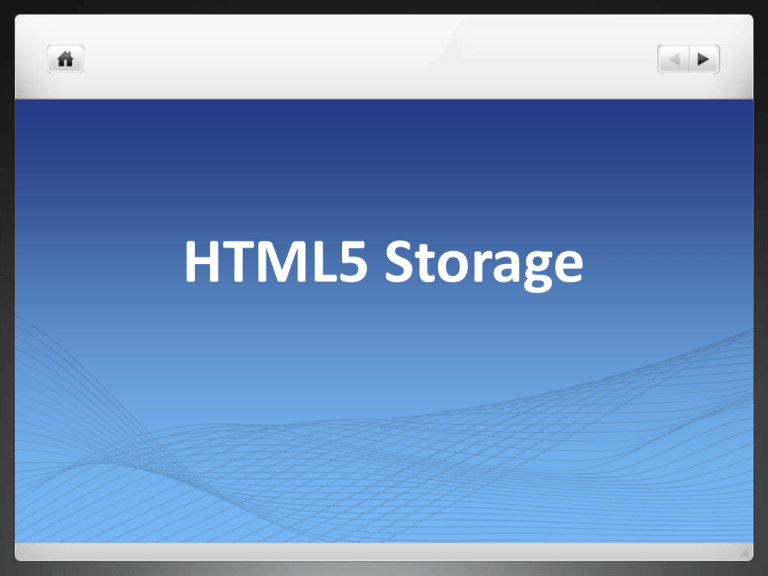HTML5 Local Storage
advertisement

HTML5 Storage
Why Local Storage?
Data accessed over the internet can never be as fast as
accessing data locally
Data accessed over internet not secure
HTML5 storage is on client
Persistent Local Storage
•
Native client applications use operating system to store data
such as preferences or runtime state
•
Stored in registry, INI files, XML or other places using key/value
pairs
•
Web applications can’t do this
Cookies
•
Invented early in Web’s history as a way to store persistent data
(“magic cookies”)
•
Small pieces of information about a user stored by Web server
as text files on user’s computer
•
Can be temporary or persistent
Cookies
•
Included with every HTTP request – slows down application by
transmitting same information repeatedly
•
Sends unencrypted data over internet with every HTTP request
•
Limited to 4KB data
•
Example: filling out a text form field
Cookies not enough
•
More storage space
•
On the client
•
Beyond page refresh
•
Not transmitted to server
History
IE: DHTML Behaviors
• userData behavior allowed 64K per domain
• Hierarchical XML-based structure
Adobe Flash (2002)
• “Flash cookies” or Local Shared Objects
• Allows Flash objects to store 100K data per domain
temporarily
History
AMASS (AJAX Massive Storage System)
•
•
•
Brad Neuberg
Flash-to-JavaScript bridge
Limited by Flash design quirks
Flash 8: ExternalInterface (2006)
•
Easier to access Local Shared Objects
AMASS rewritten
•
•
•
Integrated into Dojo Toolkit: dojox.storage
100KB storage
Prompts user for exponentially increased storage
History
Google: Gears (2007)
•
•
•
•
Open source browser plug-in
Provides additional capability in browsers (geolocation API in IE)
API to embedded SQL database
Unlimited data per domain in SQL database tables
By 2009 dojox.storage could auto-detect and provide unified interface
for Flash, Gears, Adobe AIR and early prototype of HTML5 storage (in older
version of Firefox)
Previous Storage Solutions
•
Either specific to single browser or relied on third party plug-in
•
Different interfaces
•
Different storage limitations
•
Different user experiences
HTML5 Storage
•
Provides standardized API
•
Implemented natively
•
Consistent across browsers
•
HTML5 storage is a specification named “Web Storage”
•
•
•
Previously part of HTML5 specifications
Split into its own specification
Different browsers may call it “Local Storage” or “DOM Storage”
Web Application Support
•
Supported by latest version of all browsers!
IE
8+
Firefox
3.5+
Safari
4.0+
Chrome
4.0+
Opera
10.5+
IPhone
2.0+
Android
2.0+
•
Access through localStorage object on global window object
•
Before using, detect whether browser supports it
Check for HTML5 Storage
function supports_html5_storage() {
try {
return 'localStorage' in window
&& window['localStorage'] !== null;
} catch (e) {
return false;
}
}
Or use Modernizr
if (Modernizr.localstorage) {
// window.localStorage is available!
} else {
// no native support for HTML5 storage :(
// maybe try dojox.storage or a third-party solution
}
Using HTML5 Storage
Using HTML5 Storage
localstorage object
setItem( )
getItem( )
removeItem( )
clear( )
Using HTML5 Storage
Tracking changes to the HTML5 storage area
if (window.addEventListener) {
window.addEventListener("storage", handle_storage, false);
} else {
window.attachEvent("onstorage", handle_storage);
};
Using HTML5 Storage
Tracking changes to the HTML5 storage area
The handle_storage callback function will be called with a
StorageEvent object, except in Internet Explorer where the event
object is stored in window.event.
function handle_storage(e) {
if (!e) { e = window.event; }
}
Using HTML5 Storage
StorageEvent Object
PROPERTY
TYPE
key
string
DESCRIPTION
the named key that was added, removed, or modified
oldValue
any
the previous value (now overwritten), or null if a new item was
added
newValue
any
the new value, or null if an item was removed
url*
string
the page which called a method that triggered this change
Using HTML5 Storage
• Limitations in current browsers:
• 5 MB of storage from each origin.
• Can not ask user for more storage (except for Opera,
sort of)
HTML5 in action
HTML5 in action
function saveGameState() {
if (!supportsLocalStorage()) { return false; }
localStorage["halma.game.in.progress"] = gGameInProgress;
for (var i = 0; i < kNumPieces; i++) {
localStorage["halma.piece." + i + ".row"] = gPieces[i].row;
localStorage["halma.piece." + i + ".column"] = gPieces[i].column;
}
localStorage["halma.selectedpiece"] = gSelectedPieceIndex;
localStorage["halma.selectedpiecehasmoved"] = gSelectedPieceHasMoved;
localStorage["halma.movecount"] = gMoveCount;
return true;
}
function resumeGame() {
if (!supportsLocalStorage()) { return false; }
gGameInProgress = (localStorage["halma.game.in.progress"] == "true");
if (!gGameInProgress) { return false; }
gPieces = new Array(kNumPieces);
for (var i = 0; i < kNumPieces; i++) {
var row = parseInt(localStorage["halma.piece." + i + ".row"]);
var column = parseInt(localStorage["halma.piece." + i + ".column"]);
gPieces[i] = new Cell(row, column);
}
gNumPieces = kNumPieces;
gSelectedPieceIndex = parseInt(localStorage["halma.selectedpiece"]);
gSelectedPieceHasMoved = localStorage["halma.selectedpiecehasmoved"] == "true";
gMoveCount = parseInt(localStorage["halma.movecount"]);
drawBoard();
return true;
}
HTML5 in action
•
In the saveGameState() function, we did not worry about the
data type:
localStorage["halma.game.in.progress"] = gGameInProgress;
HTML5 in action
•
But in the resumeGame() function, we need to treat the value
we got from the local storage area as a string and manually
construct the proper Boolean value ourselves:
gGameInProgress = (localStorage["halma.game.in.progress"] ==
"true");
HTML5 in action
Similarly, the number of moves is stored in gMoveCount as an
integer. In the saveGameState() function, we just stored it:
•
gMoveCount = parseInt(localStorage["halma.movecount"]);
HTML5 in action
But in the resumeGame() function, we need to coerce the value
to an integer, using the parseInt() function built into JavaScript:
gMoveCount = parseInt(localStorage["halma.movecount"]);
Beyond Key-Value Pairs: Competing Visions
Beyond Key/Value Pairs: Competing Visions
2007 – Google Gears (based on SQLite) -> Web SQL Database
openDatabase('documents', '1.0', 'Local document storage',
5*1024*1024, function (db) {
db.changeVersion('', '1.0', function (t) {
t.executeSql('CREATE TABLE docids (id, name)');
}, error);
});
Beyond Key/Value Pairs: Competing Visions
Web SQL Database
The Web SQL Database specification has been implemented
by four browsers and platforms.
Safari
4.0+
Chrome
4.0+
Opera
10.5+
Mobile
Safari
3.0+
Android
2.0+
Beyond Key/Value Pairs: Competing Visions
SQL-92
Oracle SQL
Microsoft SQL
MySQL
PostgreSQL
SQLite SQL
Beyond Key/Value Pairs: Competing Visions
Indexed Database API
Formerly known as WebSimpleDB
Now colloquially referred to as “indexedDB”
Beyond Key/Value Pairs: Competing Visions
IndexedDB
object store
Shares many concepts with a SQL database:
• Records (keys or attributes)
• Fields (values)
• Datatypes
But no query language!
Beyond Key/Value Pairs: Competing Visions
Firefox 4: An early walk-through of IndexedDB
HTML5 Rocks: IndexedDB example









